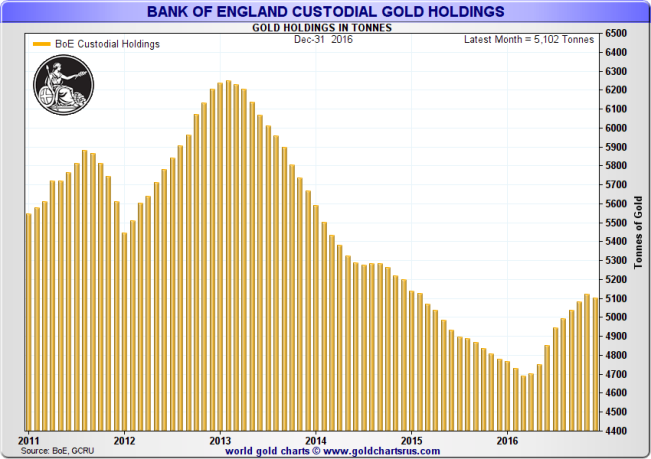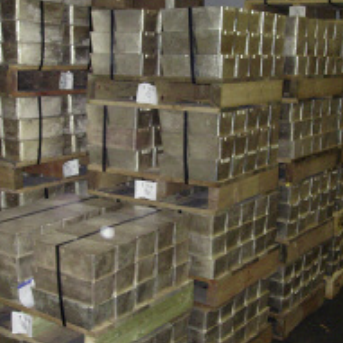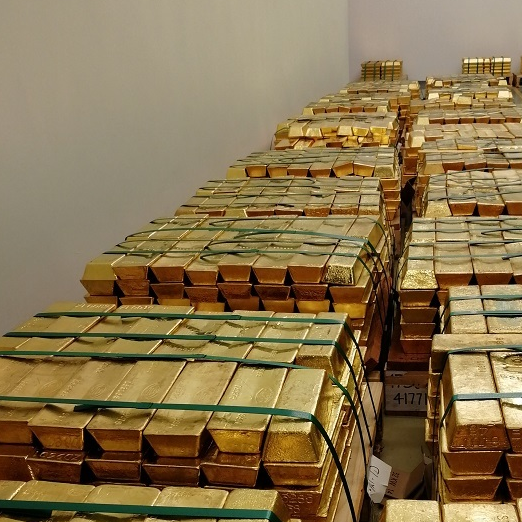Bank of England Releases New Data On its Gold Vault Holdings
An article in February on BullionStar’s website titled “A Chink of Light into London’s Gold Vaults?” discussed an upcoming development in the London Gold Market, namely that both the Bank of England (BoE) and the commercial gold vault providers in London planned to begin publishing regular data on the quantity of physical gold actually stored in their gold vaults.
Critically, this physical gold stored at both the Bank of England vaults and the commercial London vaults underpins the gargantuan trading volumes of the London Gold Market and the same market’s ‘liquidity’. Therefore, a new vault holdings dataset would be a very useful reference point for relating to London’s ‘gold’ trading volumes as well as relating to data such as the level and direction of the gold price, the volume of gold held in gold-backed Exchange Traded Funds (ETFs), UK gold import and export statistics, and Swiss and Hong Kong gold imports and exports.
The impending publication of this new gold vault data was initially signalled by two sources. Firstly, in early February, the Financial Times (FT) wrote a story claiming that the London Bullion Market Association (LBMA) planned to begin publishing 3 month lagged physical gold storage data for the entire London gold vaulting network, that would, according to the FT:
“show gold bars held by the BoE, the gold clearing banks, and those [vaults] operated by the security companies such as Brink’s, which are also members of the LBMA.”
The “gold clearing banks" are the bullion bank members of London Precious Metals Clearing Limited (LPMCL), namely, HSBC, JP Morgan, ICBC Standard Bank, Bank of Nova Scotia – Scotia Mocatta, and UBS. HSBC and JP Morgan operate precious metals vaults in London. See profile of JP Morgan’s London vault and a discussion of the HSBC vault . ICBC Standard Bank also maintains a vault in London which is operated on its behalf by Brinks.
There are 4 security companies with their own vaults in London, namely, Malca Amit, Loomis, Brinks and G4S. Therefore, including the Bank of England, there are 8 custodians with gold vaults in London that comprise the LBMA gold vaulting network.
The second publication to address the new gold vault data was the World Gold Council. On 16 February, addressing just the Bank of England vaults, the World Gold Council wrote in its Gold Investor publication that:
“The Bank of England is, for the first time, publishing monthly data revealing the amount of gold it holds on behalf of other central banks.”
“The data reveals the total weight of gold held within the Bank of England’s vaults and includes five years of historical data.”
While I had been told by a media source that the London vault data would be released in the first quarter of 2017, at the time of writing, there is still no sign of any LBMA vault holdings data covering the commercial vault operators in London. However, the Bank of England has now gone ahead and independently released its own numbers covering gold held in the Bank of England gold vaults. These gold vaults, of which there are between 8 – 10 (the number fluctuates), are located on the 2 basement levels of the Bank of England headquarters in the City of London.
In an updated web page on the Bank of England’s website simply titled ‘Gold’, the Bank of England has now added a section titled ‘Bank of England Gold Holdings’ and has uploaded an Excel spreadsheet which contains end-of-month gold holdings data covering every month for a 6-year period up to the end of December 2016, i.e. every month from January 2011 to December 2016 i.e. 72 months.

According to the Bank of England, the data in the spreadsheet shows:
“the weight of gold held in custody on the last business day of each month. We publish the data with a minimum three-month lag.
Values are given in thousands of fine troy ounces. Fine troy ounces denote only the pure gold content of a bar.
We only accept bars which comply with London Bullion Market Association (LBMA) London Good Delivery (LGD) standards. LGD bars must meet a certain minimum fineness and weight. A typical gold bar weighs around 400 oz.
Historic data on our gold custody holdings can be found in our Annual Report.”
Prior to this spreadsheet becoming available, the Bank of England only ever divulged gold vault quantity data once a year within its Annual Report, for year-end reporting date end of February.
You will appreciate that the new spreadsheet, having data for every month of the year, and for 72 months of data retrospectively, conveys a lot more information than having just one snapshot number per year in an annual report. Therefore, the Bank of England has gone some way towards improving transparency in this area.
Before looking at the new data and what it reveals, it’s important to know what this data relates to. The Bank of England provides gold custody (storage) services to both central banks and a number of large commercial banks. Large commercial banks which trade gold are commonly known as bullion banks, and are mostly the high-profile and well-known investment banks.
On its gold web page, the Bank highlights this fact – that it provides gold custody service to both central banks and commercial banks:
“We provide safe custody for the United Kingdom’s gold reserves, and for other central banks. This supports financial stability by providing central banks with access to the liquidity of the London gold market.
We also provide gold accounts to certain commercial firms that facilitate access for central banks to the London gold market.”
In the London Gold Market, the word “liquidity” is a euphemism for gold loans, gold swaps, and gold trading including gold sales. This reference to central banks accessing the London Gold Market as being in some way supportive of ‘financial stability’ is also an eye-opener, since reading between the lines, the Bank of England is conceding that by accessing the London Gold Market’s “liquidity” via bullion banks, these central bank clients are either contributing to direct stabilisation of the gold price in some shape or form, or else are using their gold operations to raise foreign currencies for exchange rate intervention and/or system liquidity. But both routes are aiming at the same outcome. i.e. stability of the financial system.
At the end of the day, the gold price has always been a barometer that central banks strive to keep a lid on and which they aim to stabilise or smoothen the gyrations of, given that the alternative – a freely formed and unmanipulated gold price – would thwart their coordination of fiat currency exchange rates, interest rates and inflation targets.
Interestingly, in addition to the new spreadsheet of gold holdings data, the Bank of England gold web page now includes a link to a new 1 page ‘Gold Policy’ pdf document, which, looking at the pdf document’s properties, was only created on 30 January 2017. This document therefore also looks like it was written in conjunction with the new gold vault data rollout.
The notion of central banks accessing the liquidity of the London Gold Market via bullion banks is further developed in this Gold Policy document also. The document is quite short and merely states the following:
“GOLD ACCOUNTS AT THE BANK OF ENGLAND
1. The Bank primarily offers gold accounts to central bank customers. This is to support financial stability by providing central banks with secure custody for their gold reserves and access to the liquidity of the London gold market (particularly given the Bank’s location).
2. To facilitate, either directly or indirectly, access for central banks to the liquidity of the London gold market, the Bank will also consider providing gold accounts to certain commercial firms. In deciding whether to provide an account, the Bank will be guided by the following criteria.
a. The firm’s day to day activities must support the liquidity of the London gold market.
b. Specifically, the Bank may have regard to a number of factors including but not limited to: evidence of active or prospective trading with a central bank customer; or whether the firm has committed to honour buy and sell prices.
3. Access to a gold account remains at the sole discretion of the Bank.
4. The Bank will review this policy periodically.”
The Vault Data
Nick Laird has now produced a series of impressive charts of this new Bank of England data on his website GoldChartsRUS. Plotting the series of 72 months of gold holdings data over January 2011 to December 2016 yields the below chart.

On average, the Bank’s vaults held 5457 tonnes of gold over this 6 year period. The minimum amount of gold held was 4693 tonnes at the end of March 2016, while the maximum quantity of gold held was 6250 tonnes at the end of February 2013.
The overall trend in the chart is downward with a huge outflow of gold bars from the bank’s vaults from the end of February 2013 to the end of March 2016.
As of January 2011, the BoE held just over 5500 tonnes of gold bars in its vaults. Gold holdings rose until the end of August 2011 and peaked at nearly 5900 tonnes before falling to 5600 tonnes at year-end 2011. Overall in 2011, the holdings fluctuated in a 400 tonne range, trending up during the first 8 months, and down during the latter 4 months.
This downtrend only lasted until January 2012, at which point BoE gold holdings totalled about 5450 tonnes. For the remainder of 2012, BoE gold under custody rose sharply, reaching 6200 tonnes by the end of 2012, a level near the ultimate peak in this 6 year chart. The year 2012 was therefore a year of accumulation of gold bars at the Bank during which 750 tonnes were added.
The overall maximum peak was actually 6250 tonnes at the end of February 2013, after which a sustained downtrend evolved through the remainder of 2013. By December 2013, gold under custody at the Bank of England had fallen to 5670 tonnes, creating an overall outflow of 580 tonnes of gold bars during 2013.
The outflow of gold continued during 2014 with another 470 tonnes flowing out of the Bank, leading to end of year 2014 gold holdings of just 5200 tonnes. The outflow also continued all through 2015 with only 4780 tonnes of gold in custody at the end of December 2015. The Bank therefore lost another 440 tonnes of gold bars in 2015.
Overall, that makes an outflow of 1490 tonnes of gold from the Bank’s vaults over the 3 years from 2013 to 2015 inclusive. This downtrend lingered for 3 more months, with another 80 tonnes lost, which brought the end of March 2016 and end of April 2016 figures to a level of about 4700 tonnes, which is the overall trough on the chart. It also means that there was a net outflow of 1570 tonnes of gold bars from the Bank’s vaults from the end of February 2013 to the end of March / April 2016.
A new uptrend / inflow trend began at the end of April 2016 and continued to the end of November 2016, where gold custody holdings peaked again at about 5123 tonnes before levelling off at the end of December 2016 at 5102 tonnes. Therefore, from the end of April 2016 to the end of December 2016, the Bank of England vaults added 400 tonnes of gold bars.
The gold holdings of the vast majority of central banks have remained stagnant over the 2011 – 2016 period, the exceptions being the central banks of China and Russia. But Russia buys domestically mined gold and stores it in vaults in Moscow and St Petersburg, so this would not affect gold holdings at the Bank of England. China’s central bank, the People’s Bank of China (PBoC), is known to buy its gold on the international market, including the London Gold Market. It then monetizes this gold (classifies it as monetary gold), and airlifts it back to China. But these Chinese purchases don’t show up in UK gold exports because monetary gold is exempt from trade statistics reporting. However, if China was surreptitiously buying gold from other central banks with gold accounts at the Bank of England or buying gold from bullion banks with gold accounts at the BoE, then some of the gold outflows from the BoE could be PBoC gold purchases. But without central bank specific data, its difficult to know.
But what is probably true is that the fluctuations in the quantity of gold stored in the Bank of England vaults are more do to with the gold holdings of bullion banks and less to do with the gold holdings of central banks, for the simple reason that central bank gold holdings are relatively static, or the least the central banks claim that their gold holdings are static. This does not take into account the gold lending market which the central banks and bullion banks go to great lengths to keep secret.

There is also a noticeable positive correlation between the movement of the US Dollar gold price and the inflows/outflows of gold to and from the Bank of England vaults, as the above chart demonstrates.
Bullion Bank gold accounts at the BoE
One basic piece of information that the Bank of England’s new vault storage data lacks is an indication of how many central banks and how many commercial banks are represented in the data.
In its first quarterly report from Q1 2014, the Bank of England states that 72 central banks operate gold accounts at the bank of England, a figure which includes a few official sector organisations such as the International Monetary Fund (IMF), European Central Bank (ECB), and Bank for International Settlements (BIS). This number would not have changed much in the meantime, so we can assume that the gold holdings of about 72 central banks are represented in the new data. But the number of commercial banks holding gold accounts at the Bank of England is less clear-cut.
The 5 gold clearing banks of the LPMCL all hold gold accounts at the Bank of England. Why? Because it says so on the LPMCL website:
“Each member of LPMCL has vaulting facilities under its control for the storage of gold and/or silver, plus in the case of gold bullion, account facilities at the Bank of England, which have contributed to the development of bullion clearing in London."
The LPMCL also states that its clearing statistics include:
“Transfers over LPMCL Clearing Members’ accounts at the Bank of England.”
Additionally, the LPMCL website states that their
“clearing and vaulting services help facilitate physical precious metal movement logistics, location swaps, quality swaps and liquidity management."
See BullionStar article “Spotlight on LPMCL: London Precious Metals Clearing Limited" for a full profile of LPMCL.
The Bank of England’s reference in its new ‘Gold Policy’ document to commercial banks needing to be “committed to honour buy and sell prices” is a reference to market makers and would cover all 13 LBMA market makers in gold, which are the 5 LPMCL members and also BNP Paribas, Citibank, Goldman Sachs, Merrill Lynch, Morgan Stanley, Société Générale, Standard Chartered Bank, Toronto-Dominion Bank. But there are also gold trading banks that make a market in gold which are not officially LBMA market makers, such as Commerzbank in Luxembourg which claims to be one of the biggest bullion banks in the world.
So I would say that lots of other bullion banks (of which there about 40 in total) have gold accounts at the Bank of England in addition to the 13 official LBMA market makers.
More fundamentally, any bullion bank that is engaged in gold lending with central banks (the central banks being the lenders and the bullion banks being the borrowers) would need a gold account at the Bank of England. I counted 28 bullion banks that have been involved with borrowing the gold of just one central bank, the central bank of Bolivia (Banco Central de Bolivia – BCB) between 1998 and 2016. Some of these banks have since merged or exited precious metals trading, but still, it gives an estimate of the number of bullion banks that have been involved in the gold lending market. The Banco Central de Bolivia’s gold lending activities will be covered in some forthcoming blog posts.
Bullion banks that are Authorised Participants (APs) for gold-backed ETFs such as the SPDR Gold Trust (GLD) or iShares Gold Trust (IAU) may also have gold accounts at the Bank of England. I say may have, because in practice the APs leave it up to the custodians such as HSBC and JP Morgan to allocate or deallocate the actual physical gold flowing in and out of the ETFs, but HSBC on occasion uses the Bank of England as a sub-custodian for GLD gold (see “SPDR Gold Trust gold bars at the Bank of England vaults" for details), so if some of the APs want to keep their own stash of allocated physical gold in relation to ETF trading, it would make sense for them to have a gold account at the Bank of England.
As to how much gold the GLD stores at the Bank of England and how regularly this occurs is still opaque because the SEC does not require the GLD filings to be very granular, however there is a very close correlation between inflows and outflows from GLD and the inflows and outflows from the Bank of England vaults, as the following chart clearly illustrates.

As gold was extracted from the GLD beginning in late 2012, a few months later the Bank of England gold holdings began to shrink also. This trend continues all the way through 2013, 2014 and 2015. Then as the amount of gold began to increase in the GLD at the end of 2015, the gold holdings at the Bank of England began to increase also. Could this be bullion banks extracting gold from the GLD, then holding this gold at the Bank of England and then subsequently exporting it out of the UK?
Some of it could, but UK gold net exports figures suggest that gold was withdrawn from both the Bank of England vaults and from the ETF gold stored at commercial gold vaults (run by HSBC and JP Morgan), after which it was exported.

Looking at the above chart which plots Bank of England gold holdings and UK gold imports and exports (and net exports) is revealing. As Nick Laird points out in this chart, over the 2013 to 2015 period during which the Bank of England gold holdings fell by 1500 tonnes, there were UK net gold export flows of 2500 tonnes, i.e. 2500 tonnes of gold flowed out of London gold vaults, so an additional 1000 tonnes had to come from somewhere apart from the Bank of England vaults.
Spot Checks
The new monthly vault holdings data from the Bank of England can now also be compared to the amount of gold reported by the Bank of England in its annual reports. The figures the Bank reports in the annual report are as of the end of February. These figures are only reported in Pounds Sterling, not quantities, so they need to be either converted to USD and divided by the USD LBMA Gold Price on the last day of February, or else just divided by the GBP LBMA Gold Price on that day.
In September 2015, I wrote the article “How many Good Delivery gold bars are in all the London Vaults?….including the Bank of England vaults”. This was followed by an October 2016 update titled “Tracking the gold held in London: An update on ETF and BoE holdings”. Both of these articles aimed to calculate how much gold was actually stored in the entire London gold vaulting network by looking at how much gold was held in custody in the Bank of England vaults and how much gold was held by ETFs in London.
For end of February 2015, the calculated total for gold held at the Bank of England (based on the annual report) came out at 5,134 tonnes. Now the Bank of England data says 5126 tonnes which is very close to the calculation. For February 2016, the calculation came out at 4725 tonnes. The new Bank of England data now says 4730 tonnes, so that’s pretty close also.
Conclusion
This new Bank of England data is welcome and the Bank of England has taken a step towards greater transparency. However, it would be more useful if the Bank published a breakdown of how much of this gold is held by central banks and how much is held by bullion banks, along with the number of central banks and number of bullion banks that the data represents. Two distinct sets of data would be ideal, one for central bank custody holdings and the other for bullion bank custody holdings. The Bank most likely would never publish two sets of data as it would show bullion bank gold storage activity for the whole world to see.
While the Bank of England has now followed through with its promise to publish its gold vault holdings, the LBMA has still not published gold vault data for the commercial gold vault providers, i.e. its members HSBC, JP Morgan, ICBC Standard Bank, Brinks, Malca Amit, Loomis and G4S. Where is this data, why is there a delay, and why has it not yet been published?
As a reminder, the Financial Times article in early February said that the LBMA would publish gold vault holdings data that would:
“show gold bars held by the BoE, the gold clearing banks, and those [vaults] operated by the security companies such as Brink’s"
The Financial Times article also said that:
“HSBC and JPMorgan, London’s biggest bullion banks, are backing the initiatives by the LBMA to improve transparency."
With the gold holdings data on the other London vaults still not published, it begs the question, has there been a change of mind by HSBC and JP Morgan, two of the LBMA’s largest and most powerful members?
The vaulting page of the LBMA’s website could also do with an update since currently it erroneously says:
“Reputedly [the Bank of England vaults are] the second largest vault in the world with approximately 500,000 gold bars held in safe custody on behalf of its customers, including LBMA members, central banks, international financial institutions and Her Majesty’s Treasury."
A holding of 500,000 Good Delivery gold bars is equal to 6250 tonnes. However, according to the Bank of England’s own figure for month end December 2016, the Bank of England only holds 5100 tonnes of gold in custody (408,000 Good delivery gold bars). Therefore, the LBMA is overstating the Bank of England’s holdings by 1150 tonnes, unless, and it’s unlikely, that the BoE vaults have seen huge gold bar inflows in the last 4 months.
Popular Blog Posts by Ronan Manly
 How Many Silver Bars Are in the LBMA's London Vaults?
How Many Silver Bars Are in the LBMA's London Vaults?
 ECB Gold Stored in 5 Locations, Won't Disclose Gold Bar List
ECB Gold Stored in 5 Locations, Won't Disclose Gold Bar List
 German Government Escalates War On Gold
German Government Escalates War On Gold
 Polish Central Bank Airlifts 8,000 Gold Bars From London
Polish Central Bank Airlifts 8,000 Gold Bars From London
 Quantum Leap as ABN AMRO Questions Gold Price Discovery
Quantum Leap as ABN AMRO Questions Gold Price Discovery
 How Militaries Use Gold Coins as Emergency Money
How Militaries Use Gold Coins as Emergency Money
 JP Morgan's Nowak Charged With Rigging Precious Metals
JP Morgan's Nowak Charged With Rigging Precious Metals
 Hungary Announces 10-Fold Jump in Gold Reserves
Hungary Announces 10-Fold Jump in Gold Reserves
 Planned in Advance by Central Banks: a 2020 System Reset
Planned in Advance by Central Banks: a 2020 System Reset
 Surging Silver Demand to Intensify Structural Deficit
Surging Silver Demand to Intensify Structural Deficit





 Ronan Manly
Ronan Manly 0 Comments
0 Comments










